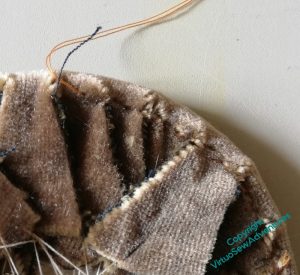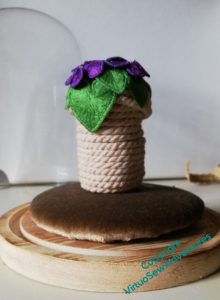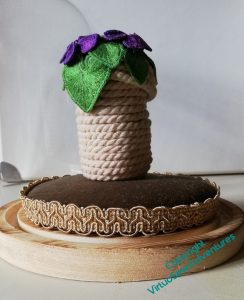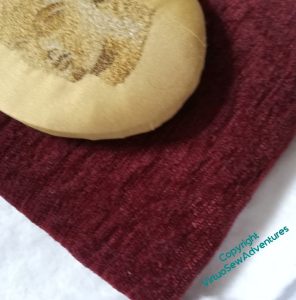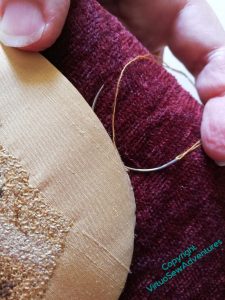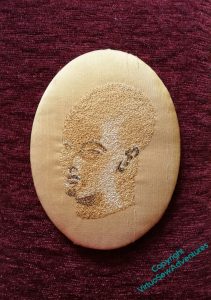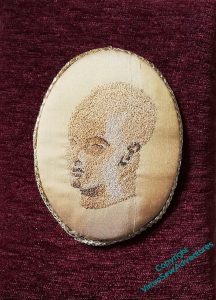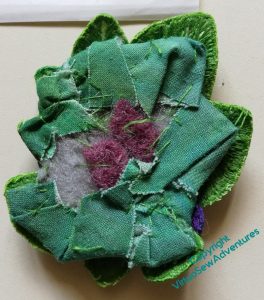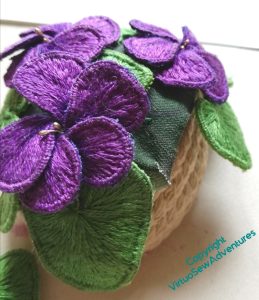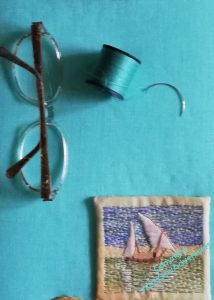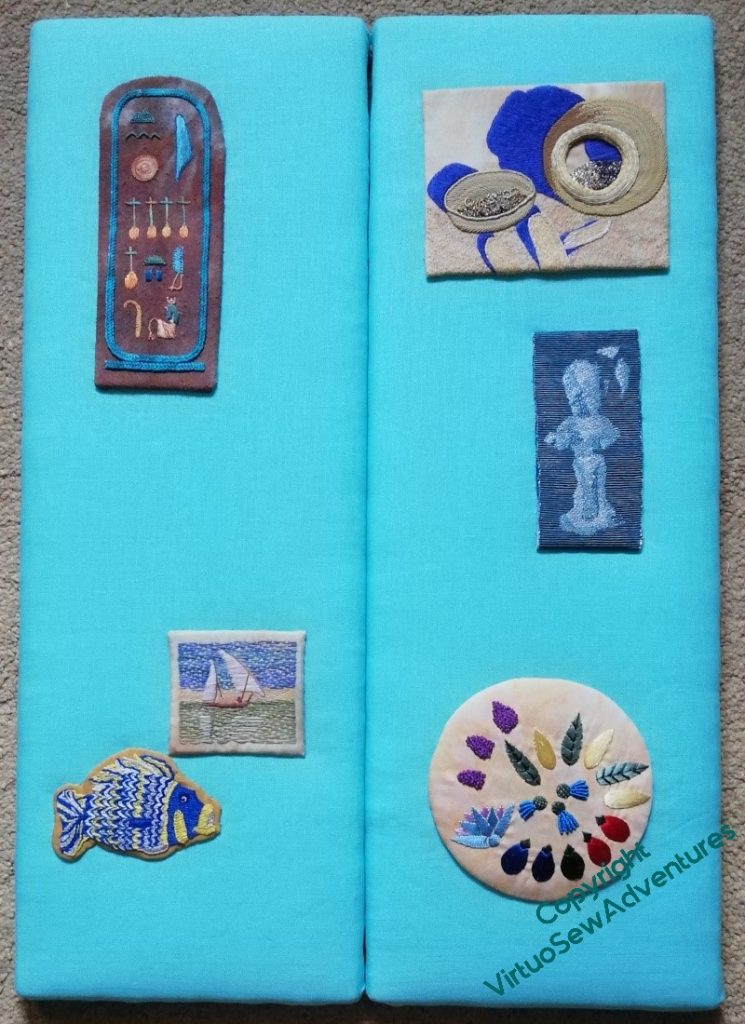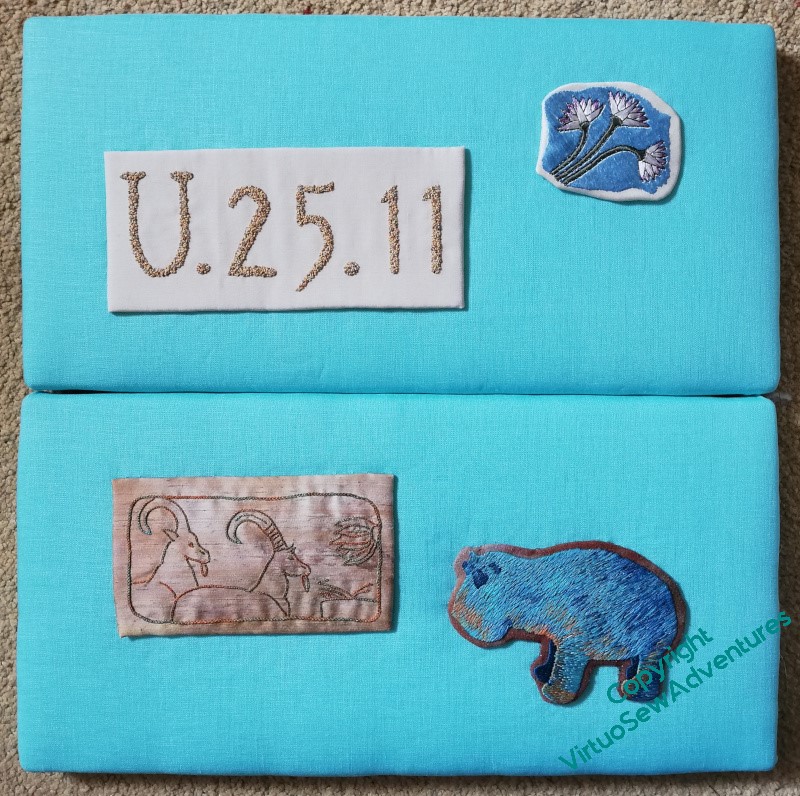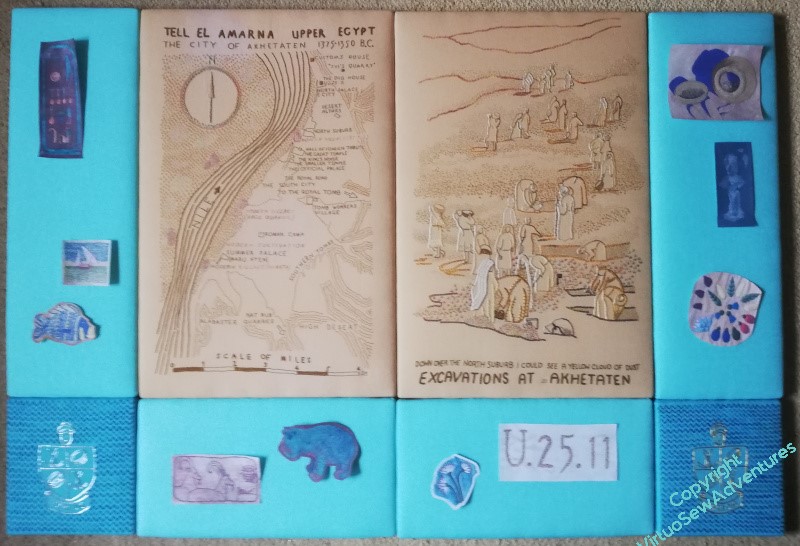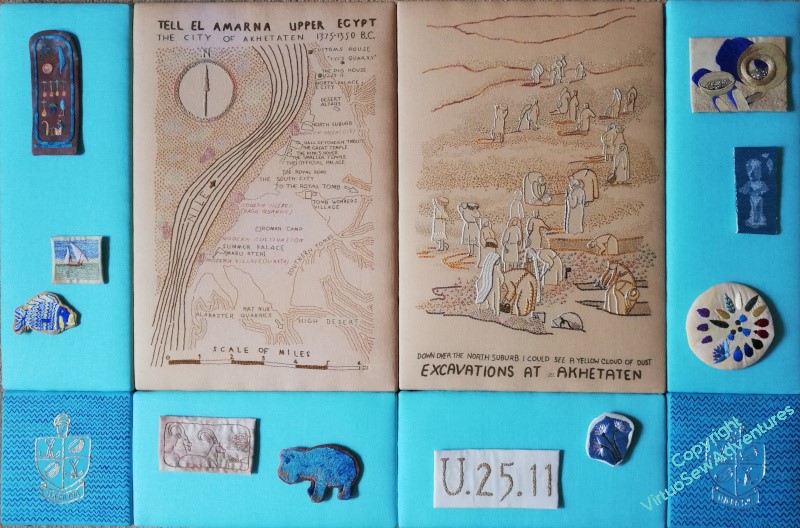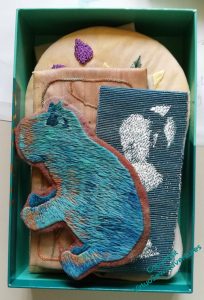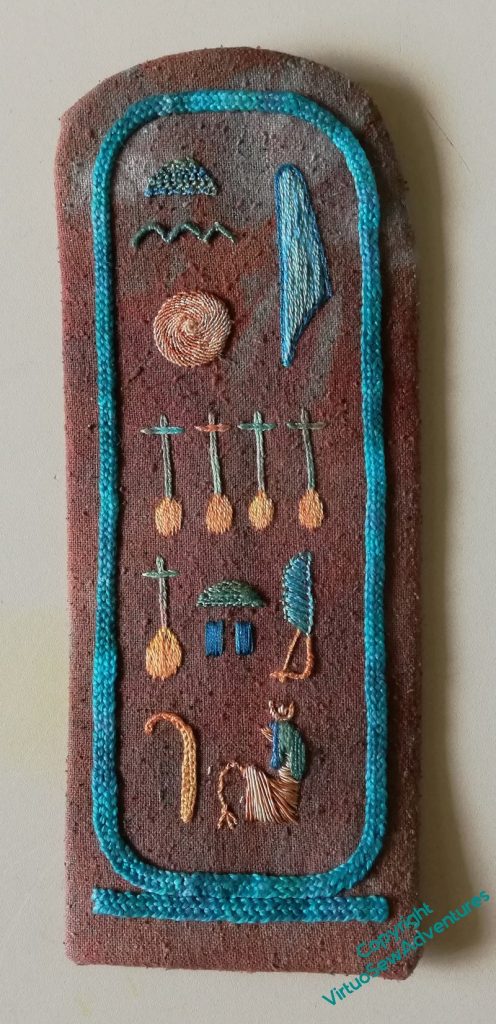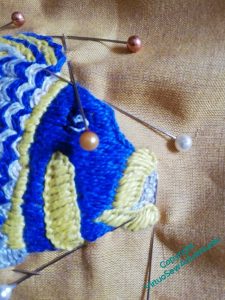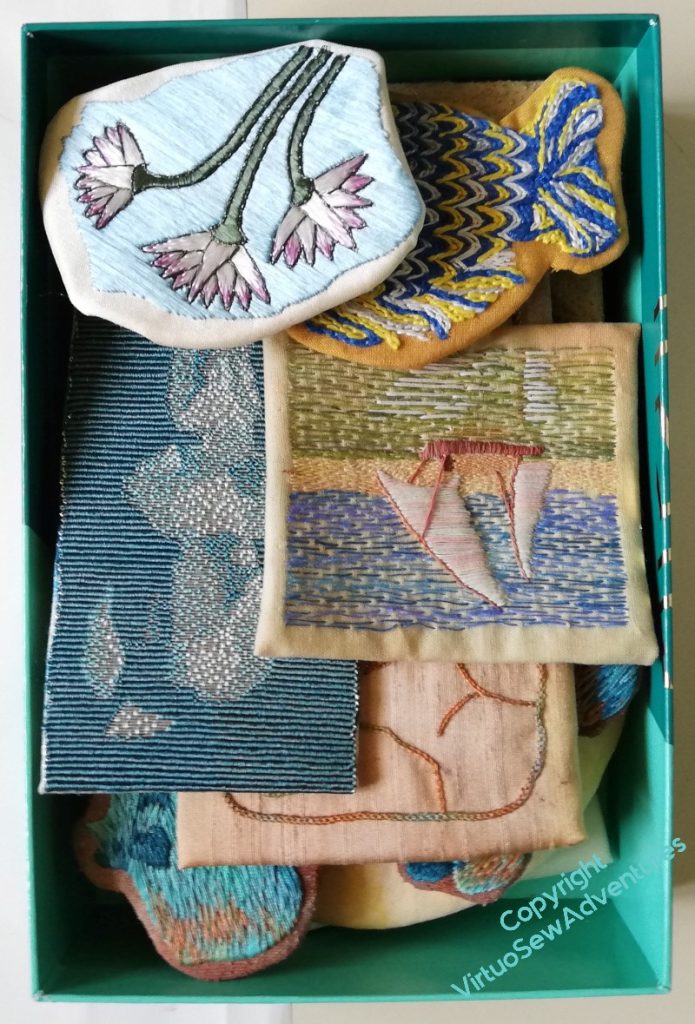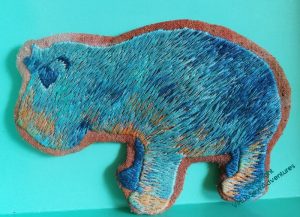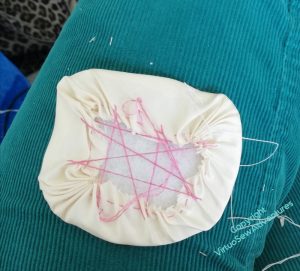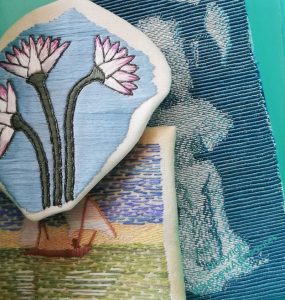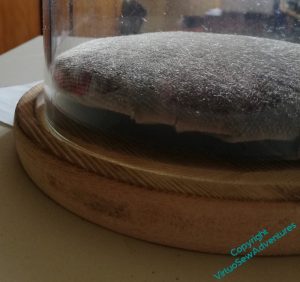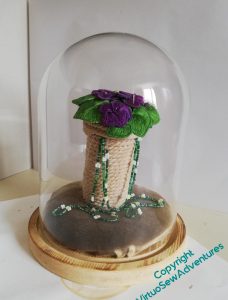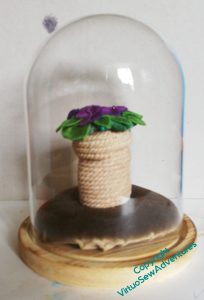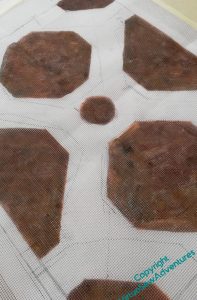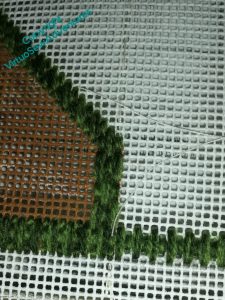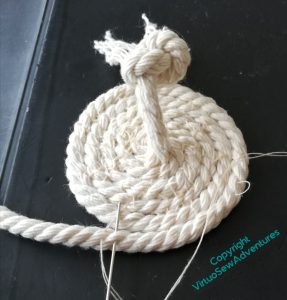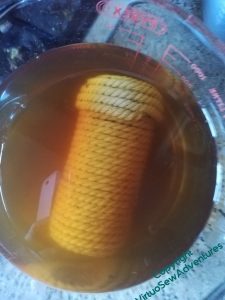About Rachel
View all posts by Rachel
Cushion For The Coiled Pot
I clipped the edges of the cushion for the coiled pot, and laced the tabs together. That was a bit less bulky than before, but still clunky and rather unstable.
<thinks hard> I wonder whether this will work…?
I stitched (that curved needle again!) close to the edge of the card mount, using a strong, doubled, cotton thread. Fortunately I’d backed the card with some heavy pelmet vilene, which meant that some stitches went into that as well as the velvet.
Then, with great trepidation, I cut off the first tab. And then the one it had been attached to.
Ooh, the whole thing didn’t disintegrate!
So I carried on , and it still didn’t disintegrate (although velvet is a very messy fabric to cut!). I tried it in place – much better, stable, lower, neater. But yes, still shedding fragments of velvet. That’s easy to fix – a couple of layers of pva glue on the underneath (me, reaching for glue? who am I, all of a sudden?!), and there’s no more shedding.
However, I do think it looks a little unfinished.
So, trimmed with a bit of furniture braid, which makes a neat little edge, slightly camouflaging what I’ve done and how.
If the daisy beads escape, it might help to keep them safe, as well.
Mounting Ankhsenspaaten
After some thought, I decided to take the inspiration of mounting for the Head of Ankhsenspaaten from Victorian mounts for minaiture portraits, so I went to my local framer, who goes by the not-at-all-exaggerated business name of “Framing Genius” (seriously, quite apart from any headaches I may give her, I’ve seen some of the other things she’s been asked to do!), and we worked out what size of oval would work for this idea. Then her clever computer controlled cutter cut out an oval that was exactly the size and proportions I wanted.
Further thought, and some playing with cards and fabrics, helped me to decide to use for her background the same burgundy chenille upholstery fabric that I eventually used to mount the Colossus of Akhenaten. None of the Amarna pieces are going behind glass – if eventual owners wish to do so, that’s their prerogative, but I like the immediacy of feeling you get, looking at a fabric or thread without any glass in the way – so the next job was to stretch the burgundy over a wooden frame and use that wretched curved needle to ladder stitch the two together.
I may be being unfair. I still don’t find a curved needle at all natural to use, but I am at least beginning not to whimper every time I look at it. It’s very useful for the purpose I’m using it for!
Once I had her neatly mounted, I sat back for some of my usual Thoughtful Staring.
The original inspiration sometimes had a cord or ribbon trim around the oval of the miniature – maybe as it stands the transition is a little abrupt?
I’ve a small collection of odd metallic cords bought at an Embroiderer’s Guild Sale, so I rummaged in that, and found something that might work.
Then I looked a little harder and realised that the thread I had used to attach the oval to the velvet would show. For the first time, I found a use for the Peri-Lusta Invisible Thread I found in my Grandmama’s workbox!
I’ve not got the gold thread quite correctly placed yet (I ran out of patience with myself at this point), so I need to spend a bit of time tweaking that, but I think where it is in the right place it is definitely improving the look.
Violets in place
When I looked again at the back of the Clump, or Mat, of violets, it became clear to me why it hadn’t followed the contours of the little pot I’d made. The padding is much too broad, and much too inflexible. It was a sensible choice to do this when I was planning to include the Violets among the spots on the main panels, but when I began to look at assembling them, the Violets and the Daisy Beads drew closer together and started to look somewhat askance at the rest of what I planned.
I began to undo the padding, and found the whole mat disintegrating on me (not really a surprise), so I went back to the beginning. I made another piece of painted calico, redesigned the pattern of my Mat, pierced holes in the new calico and began to reassemble the whole thing, with only one small piece of felt to pad it, and some extra stitching to entangle the “legs” of my petals and leaves.
I had forgotten how many extra fingers and hands that process had required the first time around.
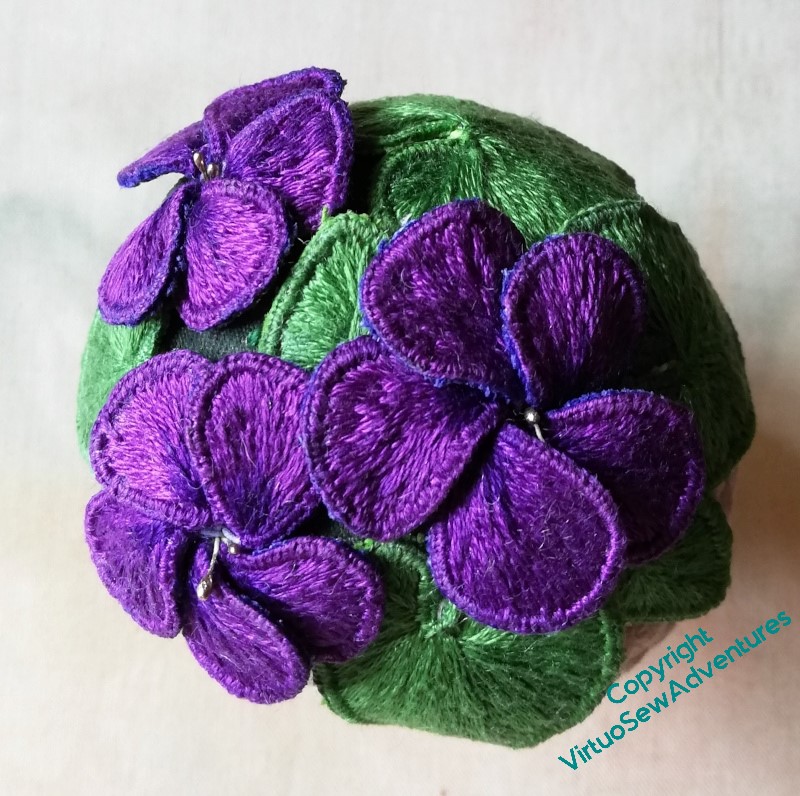
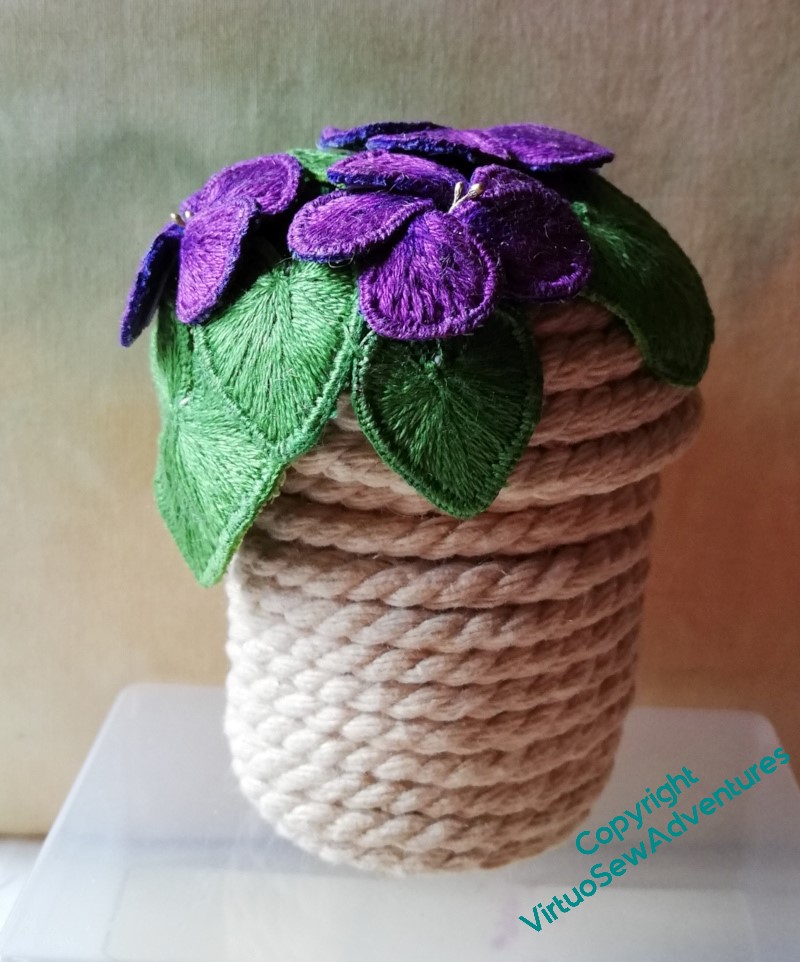
I got there in the end, I think we can say!
Reassured and making progress
After gazing long and hard at my layout, I decided that I wasn’t likely to improve it and that the thing to do was to just get started.
I’m determined to get to grips with Grandmama’s curved needles, and this is a perfect occasion to do so, because it’s so very hard to manipulate a straight needle to do what you want that even a curved needle feels like it is helping!
Grandmama’s set included three sizes, and I’m using the smallest, which is marked “lampshade”. I’ve always wrestled with a straight needle for lampshades, so who knows, this skill may prove transferable!
I’m using ladder stitch, or at least, something very like ladder stitch, and I’m beginning to feel that the curved needle genuinely does help me to make progress.
This is also the point at which I am made most aware that developing these panels into individual pieces that I work on separately has made it possible to achieve what I want. The panels aren’t huge (Placidus, when I get to him, will be much bigger), but if they were already attached to the Map or the Excavation, it would be nearly impossible to reach some of the angles I want to.
I’ve found it easiest to work on stitch lines facing away from me, and while this hasn’t been entirely straightforward in all cases, it would be altogether impossible if the turquoise panels were already attached to the sandy ones.
Especially the short ones, where I would find myself leaning over the entire height of the Map or Excavation!
I do have some concerns that the linen will sag under the weight of the Spots, so I’ve set these aside for a couple of weeks, upright, to see whether I need to gather in any Unfortunate Happenings.
Spots laid out for attachment
If you compare these two pictures, you will see what I meant by saying the embroideries had personality that the photocopies lack!
Some of it may be down to better lighting, but I think even the Map and the Excavation are looking brighter and happier.
So now they are back in their box, ready to come out one at a time to be attached to the border panels.
The details of that attachment may require some wrangling, and as for the details of attaching the panels to one another – I’m still very unsure about how that will happen. At the moment my best guess is mirror plates, but if anyone has a better idea I would love to hear it!
More spots prepared
Originally the Cartouche was going to be rectangular, but as I started to cut the pelmet vilene I’m mounting the spots on, it began speaking to me very firmly.
Long term readers know that this sometimes happens to me, and I have learnt over the years that the sensible thing to do is listen. My projects almost always know better than I what they need to thrive.
In this case, I was informed that I should make the cartouche mounting echo the curves at the top while keeping the square edges at the bottom. It wasn’t easy to do – that silk noil fabric has a way of misbehaving that would make Robin Goodfellow whistle admiringly! – but now it is done, I’m inclined to agree.
The next spot I tackled was if anything an even greater challenge – a fiddly shape (really fiddly!), in quite a light fabric, which didn’t always respond as I expected.
You can see here just how be-pinned and be-poked the poor Tilapia became! There was much clipping and snipping, muttering and tugging, before I produced something that looked at all pleasing. Maybe that’s just to remind me of the reason I did him – hearing a modern glass artist saying that he’d tried to recreate the ancient glass vessel and found it really difficult – to such an extent that even with much practice, he couldn’t expect every fish to go swimmingly (as it were…!).
So, after much cutting and stitching, tugging and thinking, I’ve mounted all the Spots around shaped pieces of pelmet vilene, ready to be attached (somehow!) to the main colour block panels of the two main Amarna pieces.
Gratifyingly, they all have much more vivid personalities than the photocopies I’ve been using to plan their placement, so I think that will genuinely work. Thank goodness!
In the meantime, I’ve got them piled up in a box, all shouting at once that they consider themselves Absolutely Splendid, and will I please Get On With It…!
Preparing the “Spots”
Once I had some sense that I knew which blocks went where, and what shape I wanted them to be, I could begin to mount them. Some of them will be distinctly tricky, such as the Lotus Tile Fragments, the Nile Tilapia, and (especially), the Faience Hippopotamus.
Since I also picked up a shoulder injury, all this was slowed down by the necessity to do little bits at a time, rather than a whole orgy of concentration.
I worked on the Lotus Tile Fragment while I was stewarding an exhibition that some of my paintings were in. It’s a good idea to have something to do that’s small and easy to put down for that sort of occasion. It’s not a great look to loom at people who’ve come to stroll around, but equally, sitting, hands folded, demure and silent, might also put them off. Looking up with a friendly grin and then returning to something that’s plainly small and interruptible is a useful position between those extremes. ( I sold a painting, too!)
I had a very useful, and suitably faience coloured little box to hand in which all the pieces, so far, have fit rather neatly, keeping them dust-free and untangled.
It’s remarkably satisfying to see them all stacking up, and I have had an idea about details of display in the eventual, hoped-for, exhibition: I could do “record cards” for each piece in the style of something recorded from an excavation, thus providing information, but maintaining the theme.
So now, the question is – what information should I include?
More Experiments with a Parlour Dome
Once I had put together my coiled pot of cord, and, at the very least, I could feel I had something to play with, I had a look at how to assemble the parlour dome display.
I intended to set the pot upon a little velvet cushion; that will give the sense of something “presented” rather than simply stashed away from the dust. Furthermore, I had some cotton velvet in a sort of inderminate brown, taken off a piano stool, which I thought would combine being unobtrusive with being sufficiently present. However, my first attempt to stretch the velvet over the padded card has left me with something that sticks a bit, and raises the card (and thus anything on it) rather further than I anticipated. More thought needed here, I feel.
While that thinking continued, I thought I might as well play with the whole display, to find any other difficulties so that I could think about those as well.
The tea-dyeing has worked, I think: the daisy beads stand out nicely, but it’s not the sort of high contrast that would overwhelm them.
And I think the beads flowing out of the pot and down onto the velvet work as well. The textures and scales seem to be properly in tune with one another.
But I think the pot is too tall, and the violets stick out a bit too much. Violets are “mat forming”, apparently, so I would expect them to follow the contours of the lid a little more closely, shading the beads.. And somehow, with the pot so tall, I feel that the violets can’t breathe.
And indeed, although this photo is rather hurried (you can even see the pin holding the violets in place), I think it shows what I mean. The shorter pot gives the violets more air, and somethow that makes for a pleasanter display.
However, I do still need to find a solution for the Problem Of The Cushion!
Beginning The Knot Garden
A “Site Visit” recently gave me the chance to look at my wools in the room for which the cushion is destined, and to talk to my cousin about the whole thing. It also provided a reminder of the truism that, no matter how extensive the stash, for any particular project, the stash will prove inadequate!
I had my experimental panel with me, and one of the things my cousin said was that she was not particularly taken with the effect of the tent stitches or straight stitches infilling between the pattern stitches. I agreed that it looked a bit clunky and congested, so when I got home again, I got out my acrylic paints and painted the canvas, just the area of the borders.
What I have done is to use three different shades of brown, solo and in mixtures. And I’ve painted both sides of the canvas, to make the coverage a bit more thorough. This way, I’m not trying to produce an absolutely flat colour, as though the canvas were dyed or coloured from the start.
You can also see in this picture that the “pathways” spill out into the surrounding canvas. I was intending the stitching to do so as well, but there’s an old saying in military circles, that “No plan survives contact with the enemy”. I would adapt that for stitchers – I don’t regard the canvas as my enemy, but no plan survives the first stitching session unchanged!
I started to work the Parisian Stitch border around the beds, using two different colours of crewel wool in the needle, and soon decided that although I want to have a couple of rows of tent stitch around the outside, to help with adding the back to the cushion, I also want the pattern area properly delimited. So the line between the beds will be filled with a line of Parisian stitch as well.
Experiments with A Coiled Pot
You may recall that I had an idea to combine the Daisy Beads and the Stumpwork Violets into a little display under a parlour dome. The colours and scale don’t work with the main panels, and besides, both items are tied specifically to Mary in a way that nothing else is.
My first thought was a gold trinket pot, but so far I have entirely failed to find a pot of the right sort of dimensions. For some reason, everything I could find was too wide or too high, or not the right surface for gilding.
So after some frustration, I decided to tie the display back to the excavations by using a coiled pot made using braid or cord. It should be slightly reminiscent of the baskets used to carry away spoil from the excavations.
After some experimentation, I settled on piping cord, sewn together with ordinary sewing cotton as I wrapped the cord around a former (a spice jar, since you ask). Even that involved some unpicking and restitching.
When I’d done it, however, it was too white and stark, not a kindly background for the Daisy Beads. Hmmm…
So that is how I found myself tea dyeing a coiled pot made of piping cord!

